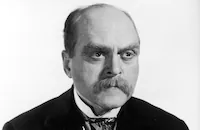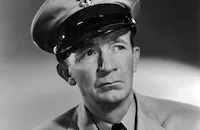Seven Keys to Baldpate

Brief Synopsis
Cast & Crew
William Hamilton
Gene Raymond
Margaret Callahan
Eric Blore
Grant Mitchell
Moroni Olsen
Film Details
Technical Specs

Synopsis
As a winter storm rages, Magee, a novelist, arrives in the summer resort of Asquewan Junction and checks in at the Baldpate Inn, where he is left alone by the caretakers and given the "only key" to the hotel. To make good on a bet with a friend that he can write a novel in twenty-four hours, Magee soon finds himself spying on the strange activities of Bland, a gangster. After Bland makes a suspicious telephone call, he deposits an envelope in the inn's safe and confronts the snooping Magee at gunpoint. Magee tricks Bland into locking himself in his room and then bumps into Mary Norton, who claims to be a down-on-her-luck actress. The inn's next unexpected visitors are Professor Bolton, Adlebert Peters, Baldpate's woman-hating hermit, and the exotic Mrs. Hayden, who confides in Magee that Bland's boss, Jim Cargan, a private detective, is trying to extort $200,000 from her husband for the return of her stolen jewels. A confused Magee then sees both Mary and Bolton trying to open the safe, which Mary explains contains Hayden's $200,000. After Mary shows Magee the inn's secret passage, Bland, who had jumped out of Magee's window, Hayden and Cargan arrive and open the safe. With the help of his "trigger man," Max, Cargan double-crosses his cohorts and runs off with the money, but is knocked out by Bolton, who is then knocked out by Magee. After Magee hides the cash in a vase, Bland accidentally stumbles on it and hides it in a woodstove, which is opened by Peters, who then transfers the money to a chair cushion. While Mary attempts to retrieve the cash, Magee is confronted by the gangsters and Hayden, who implicates himself in an insurance scam. In the heated confusion, Mrs. Hayden, who is actually an impostor named Myra, reveals that Max stole Hayden's jewels at Cargan's request. Max shoots and apparently kills Myra. Finally, the police arrive and, once assured that Myra is not dead, hear Magee's accusations. Mary then reveals that she is really Mary Johnson, a New York reporter, and Bolton confesses that he is really Harrison, an insurance detective. Although Magee loses his literary bet, he is rewarded with Mary's hand in marriage.

Cast

Gene Raymond
Margaret Callahan

Eric Blore

Grant Mitchell

Moroni Olsen
Erin O'brien-moore

Henry Travers

Walter Brennan
Ray Mayer
Erville Alderson
Murray Alper
Harry Beresford
Emma Dunn
Monte Vandergrift
Philip Morris
Crew
Alberto Colombo
Robert De Grasse
Charles Kerr
Charles Kirk
Desmond Marquette
Van Nest Polglase
William Sistrom
Wallace Smith
John E. Tribby
Glenn Tryon
Anthony Veiller
Dorothy Yost

Film Details
Technical Specs

Articles
Seven Keys to Baldpate
By Richard Harland Smith

Seven Keys to Baldpate
Quotes
Trivia
George M. Cohan's play opened in New York on 22 September 1913.
Notes
Motion Picture Herald's "In the Cutting Room" includes Molly Lamont in the cast, but her pariticipation in the final film has not been confirmed. The New York Times reviewer complained that the film's producers "neglected to explain that the mysterious goings-on were prearranged carefully to thwart a writer who had a bet," as was the case in Biggers' novel. This version of Biggers' novel was preceded by three others: a 1917 Artcraft picture, directed by Hugh Ford and starring George M. Cohan (see AFI Catalog of Feature Films, 1911-20; F1.3939); a 1925 Paramount release, directed by Fred Newmeyer and starring Douglas MacLean, and a 1930 RKO release, directed by Reginald Barker and starring Richard Dix (see AFI Catalog of Feature Films, 1921-30; F2.4920 and F2.4921). In 1947, Lew Landers directed Phillip Terry in a second RKO version of the novel.














